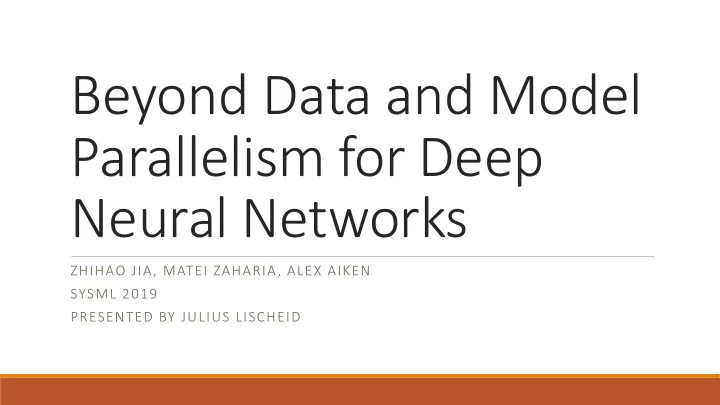

Beyond Data and Model Parallelism for Deep Neural Networks ZHIHAO JIA, MATEI ZAHARIA, ALEX AIKEN SYSML 2019 PRESENTED BY JULIUS LISCHEID
Existing Parallelisation Approaches (1/2) DATA PARALLELISM MODEL PARALLELISM • Replica of neural network on each device • Disjoint subsets of neural network assigned to devices • Each device processes subset of training data • No parameter synchronisation, but requires • After each iteration, parameters are data transfers between operations synchronised • Works well for compute-heavy operations with few parameters (e.g. convolutions)
Existing Parallelisation Approaches (2/2) EXPERT-DESIGNED STRATEGIES AUTOMATED FRAMEWORKS • A. Krizhevsky. One weird trick for parallelizing • A. Mirhoseini et al. Device Placement convolutional neural networks. CoRR 2014. Optimization with Reinforcement Learning. ICML 2017. • Data parallelism for convolutional layers, model • Reinforment learning for model parallelism parallelism for fully-connected layers • Y. Wu et al. Google’s neural machine translation • Z. Jia et al. Exploring hidden dimensions in system: bridging the gap between human and parallelizing convolutional neural networks. CoRR machine translation. CoRR 2016. 2018. • Data parallelism for compute nodes, model • Dynamic Programming for parallelisation of DNNs parallelism for intra-node computation with linear computation graphs • D. Narayanan et al. PipeDream: generalized pipeline parallelism for DNN training. SOSP 2019. • …
The SOAP Search Space Samples (data parallelism) Operators (model parallelism) Attributes (e.g. pixels) Parameters (≈model parallelism)
Hybrid Parallelism in SOAP Example parallelization strategies for 1D convolution
FlexFlow • Trying out strategies on hardware is expensive due to long iteration times • Execution Optimizer uses simulator instead • Measures operator runtime on hardware • Estimates runtime of parallelisation strategies • Delta simulation algorithm uses incremental updates for acceleration • Execution optimizer explores search space with Markov Chain Monte Carlo algorithm
Evaluation (1/2)
Evaluation (2/2)
Review (1/2) STRENGTHS/AGREEMENTS WEAKNESSES/DISAGREEMENTS • Expands search space for parallelisation • Unclear how much SOAP and execution strategies optimiser contribute to training acceleration • Proposes a way to efficiently explore that • Usefulness of Attribute dimension is search space questionable • Leads to an actual speed-up • More end-to-end performance benchmarks would have been useful
Review (2/2) KEY TAKEAWAYS POTENTIAL IMPACT • Training performance of parallelisation • Usage of other search algorithms to explore strategies can be efficiently and accurately parallelisation search space in simulation predicted • Combination of parallelisation search space • The resulting speed-up allows for the with computation graph substitutions exploration of a wider search space (compare Tim’s presentation next week)
Questions? P A S O
Image Citations Images with beige background retrieved from Jia Zhihao’s SysML 19 talk: https://www.youtube.com/watch?v=81l6kkV-OkE All other images extracted from Z. Jia, M. Zaharia, and A. Aiken: Beyond Data and Model Parallelism for Deep Neural Networks, SYSML, 2019.
Recommend
More recommend